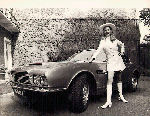
... and the story goes on
In 1971 it became apparent to the David Brown Corporation that Aston
Martin Lagonda was not going to be able to fit in their long-term plans and
the decision was taken to sell the Company. On 16 February 1972 Company
Developments, a Birmingham-based group of businessmen, acquired the
whole of the issued share capital, Sir David Brown retaining a seat on the
Board of Directors and becoming President of the Company and Mr William
Willson becoming the new Chairman.
Production of the DBS and DBS V8 continued until May 1972, when modified
versions of the two cars appeared and with them, the deletion of the
reference to DB.
The revised models were renamed the Aston Martin Vantage, the six-cylinder
car, now available only with the high performance Vantage engine and the
Aston Martin V8. Both cars had revised frontal treatment, using two larger
headlamps in place of the original four small ones.
The following year saw the production of the last six-cylinder car and the
change from the original fuel injection on the V8 to carburettors.
In 1974 Company Developments decided to sell Aston Martin Lagonda and at
the end of that year production was halted whilst a buyer was sought.
In June 1975 possession of the Company was secured by North Americans
Peter Sprague and George Minden, shortly to be joined by Englishman Alan
Curtis. Immediate plans were put in hand to revitalize the Company and a
direct result of this was the appearance of the new Aston Martin Lagonda at
Earls Court in 1976. With coachwork by William Towns, who had previously
styled the DBS, its strikingly modern appearance and very advanced
specification made a considerable impact.
The following year saw the introduction of very high performance version
of the V8, called the Aston Martin V8 Vantage. In June 1978 a convertible
version of the standard car, called the Volante, was unveiled, initially for
the export market, to be followed in October by a revised version ofthe
standard car, giving it a more refined appearance and even more luxurious
interior.
March 1980 saw the appearance of another very advanced car which was to
be known as the
Bulldog.
In the same year the Lagonda came into full production.
The early 1980's saw Aston Martin Lagonda change hands once again, for in
January Pace Petroleum - a private petroleum distribution company led by
Victor Gauntlett - and C.H. Industrials, a public Company chaired by Tim
Hearley, took control. Both had in fact joined the board the previous year.
The name Aston Martin has been continuously associated with motor racing
since the Company's earliest days and ceased only when David Brown
withdrew in 1963, due, in part, to steeply climbing costs.
In 1982 the Company took a step back into the competition field through an
association with Nimrod Racing Automobiles. This was a small joint concern,
started by Robin Hamilton, who ran an Aston Martin distributorship in
Staffordshire, and Victor Gauntlett, and was formed to run cars in the World
Endurance Championship class of racing. Aston Martin supplied racing
engines and back-up services to Nimrod, and at the end of their first
competition year Nimrods finished third in the Championship, having fin-
ished seventh in general classification at Le Mans.
In July 1983, Automotive Investments - distributors of Aston Martin and
Lagonda cars in the United States - purchased the Pace Petroleum shares in
the Company. Under the agreement, Automotive Investments owned 55 per
cent of Aston Martin Lagonda, with C.H. Industrials owning the remaining
shares. Mr Gauntlett remained with the Company as Executive Chairman.
In February 1984, C.H. Industrials sold their remaining shares to Automotive
Investments who controlled 100 per cent ofthe Company until October 1984,
when the family of Peter Livanos took 75 per cent, and Mr Gauntlett 25 per
cent.
In March 1986, Aston Martin unveiled the 300 kph Vantage Zagato, ofw hich
just 50 would be built. In the following year a convertible version was
unveiled and this was destined to be an even rarer car, for just 35 were
produced.
The year of 1987 was also notable for two other events. Aston Martin again
teamed up with James Bond in 'The Living Daylights', while in September it
was announced that Ford were to purchase 75 per cent of the Company's
shares, with the remaining 25 per cent being owned equally by the Livanos
family and Mr Gauntlett, who was to stay as Executive Chairman and Chief
Executive.
In October 1988, the Virage was unveiled at the British Motor Show.
Designed
to take the Company into the 21st century, this 155 mph, two-door, 2+2
replaced the V8, which had been in production for 20 years.
The all-new British-styled Virage contained a number of innovative
features,
yet retained the style and craftsmanship so long associated with the marque.
In September 1991, long-serving Executive Chairman Victor Gauntlett
resigned and was replaced by Walter Hayes, a former Vice-Chairman of Ford
of Europe.
The year of 1992 was a busy one for the Company, with the announcement of
a 6.3-litre coriversion of the Virage in January, and the unveiling of a
Shooting Brake version at the Geneva Show in March. That show also saw
the debut of the production version of the Virage Volante.
This is where my official factory provided history paper ended.
Internet is about information-sharing. You can feature the
contents of my pages AFTER contacting me and let me know about Your intention

Since 1992:
The company has its hand full of orders so they are on the right track
right now.
© April 1995 - 1997. Paul Negyesi
npaul@hu.inter.net